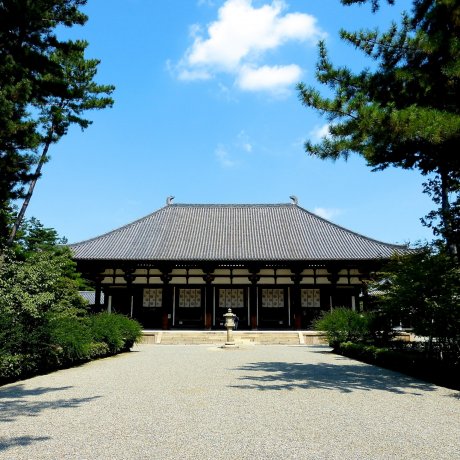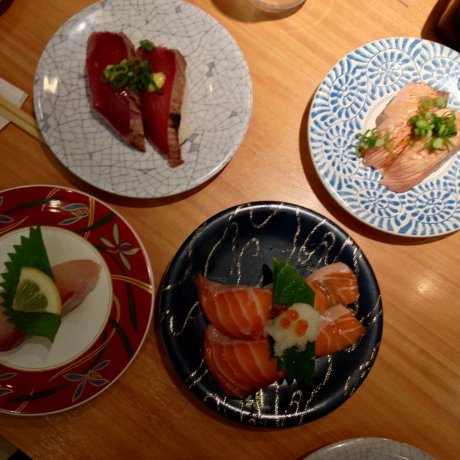
Nara Toshodai-ji Temple in Autumn
Tomoko KamishimaToshodai-ji Temple in Nara is the head temple of the Ritsu sect of Buddhism in Japan. The Ritsu sect mainly studies and practices..

Toshodaiji Temple, located just north of Yakushiji Temple in Nara, is a significant site related to the development of Buddhism in Japan and signifies a connection between Japanese and Chinese cultures.
The prestigious temple was founded in 759 by the Chinese monk Ganjin, who traveled to Japan in 754 after being asked by the emperor to help train monks and improve Japanese Buddhism. After retiring, Ganjin was granted land and consequently, established Toshodaiji to continue teaching Chinese Buddhist principles. Today, the temple is recognized as a UNESCO World Heritage Site.
Without a doubt, Toshodaiji’s most impressive structure is its Kondo, or Main Hall, which was reopened to visitors in 2009 after nearly ten years of reconstruction work. The one-story Kondo, situated directly behind the Nandai-mon (Southern Great Gate), is the epitome of early Japanese-Buddhist architecture with a tiled sloping roof, seven bays, columns, and dark wood tones. Due to the building’s columned facade, it is often compared to the Parthenon. Inside, the hall houses principal Buddhist statues, which are designated as National Treasures. Standing before the hall, you cannot help but be swept away by its commanding presence.
Near the Kondo is the Kodo Lecture Hall. This structure was originally built as an administrative building for the Nara Imperial Palace, but later relocated to Toshodaiji after it was gifted to Ganjin. Today, the hall is the only surviving building of the palace, and thus, a historically significant and rare part of the temple.
Another prominent temple building is the Miei-do, which enshrines a famous wooden sculpture of Ganjin that his disciples created using hollow-core, dry-lacquer techniques. The exclusive building is only open to the public for a few days a year around June 6th. For all other days, visitors can view a replica of the statue, which was made on the 1,250th anniversary of Ganjin’s death, on display at the nearby Kaizando.
In the eastern woods of the precinct lies Ganjin’s grave, one of the most tranquil areas of the temple. Follow a nature-laden path through thick foliage and then cross over a small bridge into the peaceful haven.
Toshodaiji is also home to monk sleeping quarters, storehouses for sutras and treasures, and the Koro (Shariden), which is the site of the Uchiwamaki Ceremony, or Fan Scattering Festival, on May 19. Be sure to visit this remarkable temple and walk the footsteps of one of the most influential Chinese monks of Japanese Buddhism.
If you are starting in Nara, take the Kintetsu Nara Line from Kintetsu Nara Station to Yamato-Saidaiji Station, then transfer to the Kintetsu Kashihara Line to Kintetsu Nishinokyo Station. From there, Toshodaiji is about a 10-minute walk.
Alternatively, start at JR Kyoto Station and walk to Kintetsu Kyoto Station. Take the Kintetsu Kyoto Line or Kintetsu Limited Express to Yamato-Saidaiji Station. From Yamato-Saidaiji Station, take the Kintetsu Kashihara Line to Kintetsu Nishinokyo Station, and then walk about 10 minutes to the temple.

Toshodai-ji Temple in Nara is the head temple of the Ritsu sect of Buddhism in Japan. The Ritsu sect mainly studies and practices..

Tōshōdaiji Temple - historic monument of ancient Nara


Enjoy one night under the sign of Japanese hospitality in Matsumae Ryokan, in Nara City.



Royal Copenhagen is a Danish manufacturer of porcelain products with a history dating back to 1775. A limited-time event at the..

A limited-time afternoon tea event at the JW Marriott Hotel Nara celebrates the release of the movie "Peter Rabbit 2: The Runaway"...

Yakushiji Temple is regarded as one of the oldest and most important temples in Japan, which is no surprise given its impressive status. The temple is..

NARA Visitor Center & Inn is located by the Sarusawa Pond in Nara City, a short walking distance from Kintetsu Nara station and Nara station. It is the..

Todai-ji Temple, also known as the Great Eastern Temple, was originally built in 752 at the behest of Emperor Shomu. It is one of the most famous and..
Your feedback has been sent.